Organisational Behaviour Report: Motivation, Teams, and Philosophies
VerifiedAdded on 2021/01/01
|16
|5183
|67
Report
AI Summary
This report delves into the complexities of organisational behaviour, focusing on how power, politics, and culture influence individual and team performance within the context of A David & Co. It explores the Handy culture adopted by the company and its implications, along with the impact of politics and power dynamics. The report further examines content and process theories of motivation, including Herzberg's two-factor theory and Locke's goal-setting theory, to enable effective goal achievement. It differentiates between effective and ineffective teams, analyzing team dynamics and the philosophies of organisational behaviour. The report concludes with an overview of how these elements intertwine to shape organisational outcomes, providing insights into management strategies and employee satisfaction within the food and beverage industry.
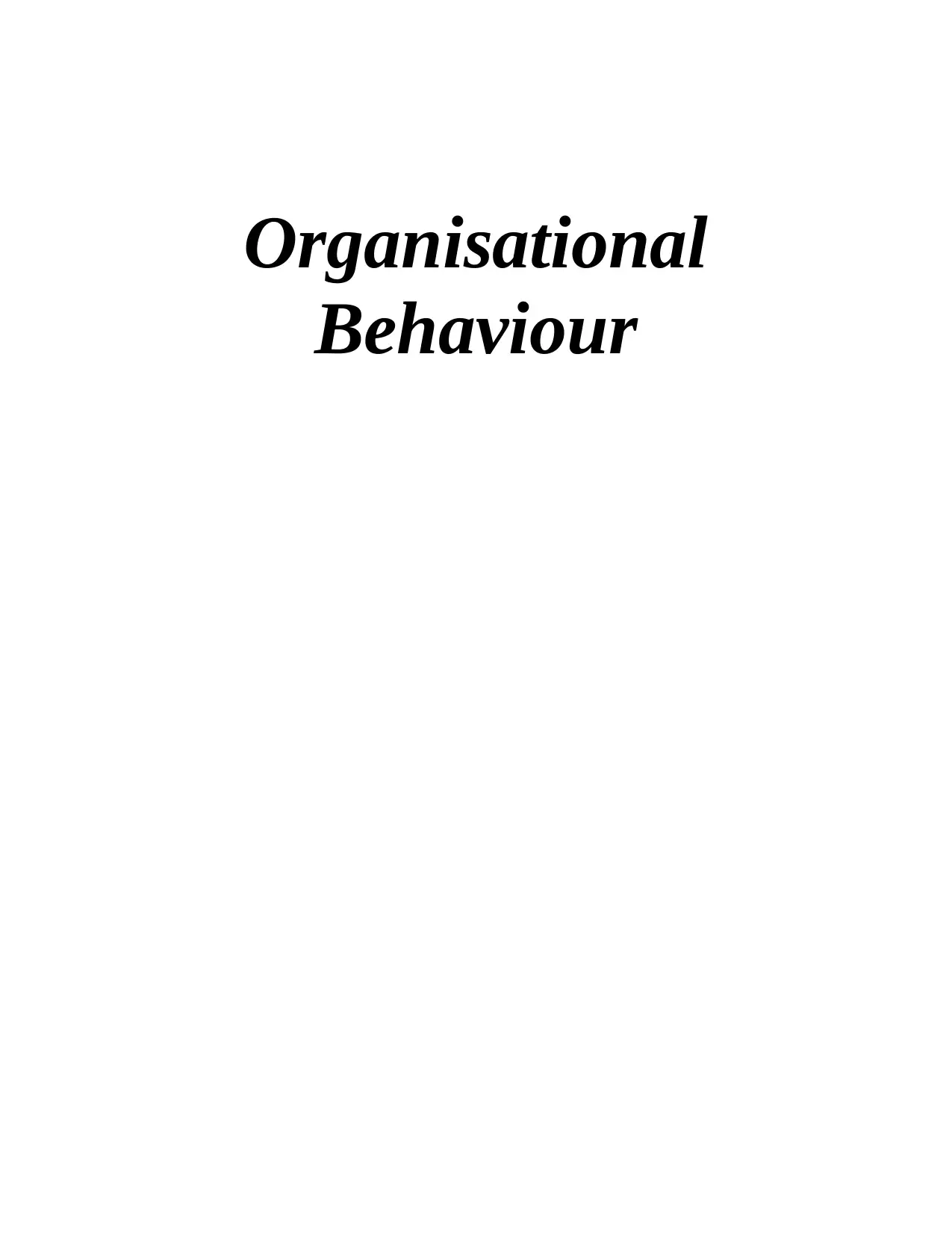
Organisational
Behaviour
Behaviour
Paraphrase This Document
Need a fresh take? Get an instant paraphrase of this document with our AI Paraphraser
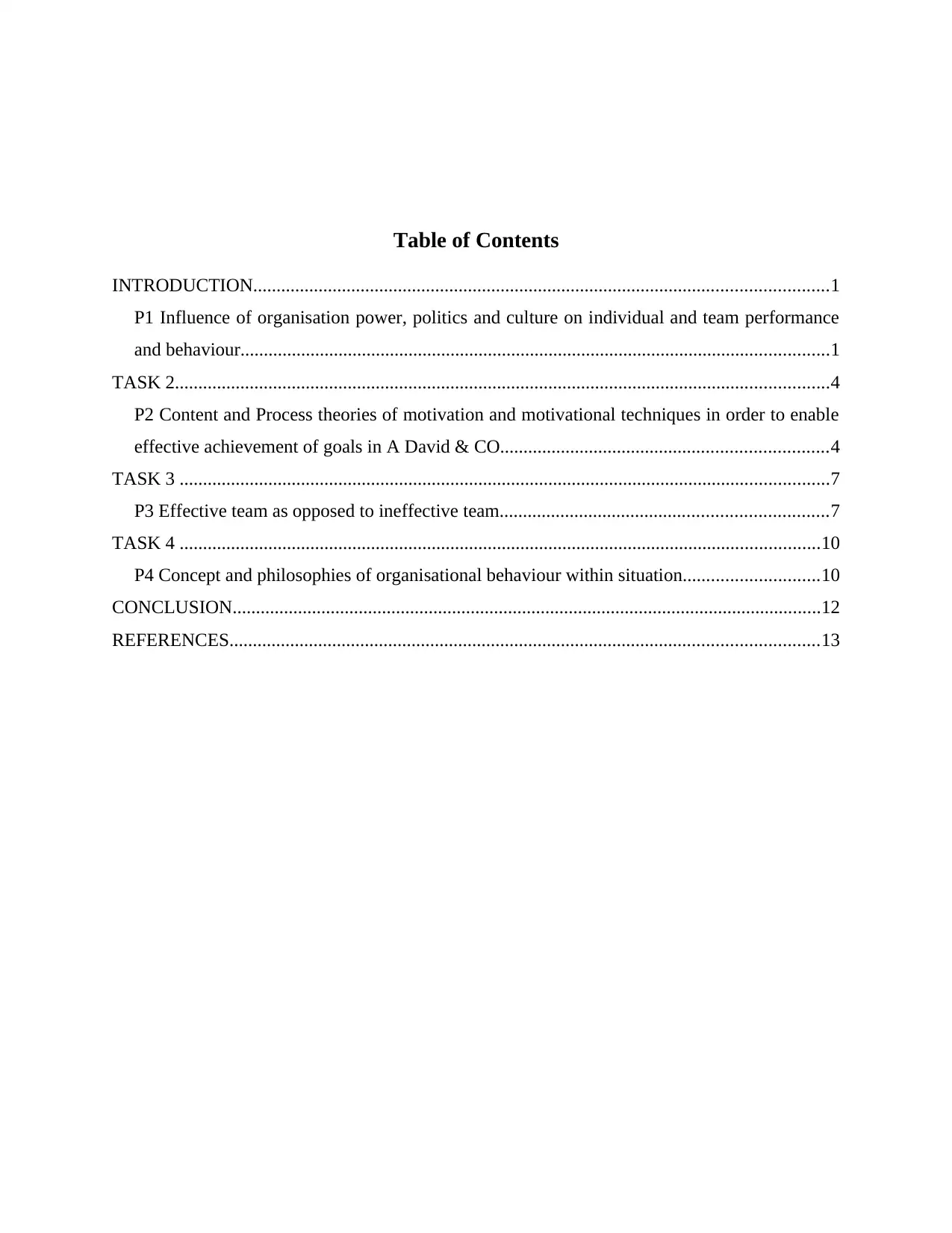
Table of Contents
INTRODUCTION...........................................................................................................................1
P1 Influence of organisation power, politics and culture on individual and team performance
and behaviour..............................................................................................................................1
TASK 2............................................................................................................................................4
P2 Content and Process theories of motivation and motivational techniques in order to enable
effective achievement of goals in A David & CO......................................................................4
TASK 3 ...........................................................................................................................................7
P3 Effective team as opposed to ineffective team......................................................................7
TASK 4 .........................................................................................................................................10
P4 Concept and philosophies of organisational behaviour within situation.............................10
CONCLUSION..............................................................................................................................12
REFERENCES..............................................................................................................................13
INTRODUCTION...........................................................................................................................1
P1 Influence of organisation power, politics and culture on individual and team performance
and behaviour..............................................................................................................................1
TASK 2............................................................................................................................................4
P2 Content and Process theories of motivation and motivational techniques in order to enable
effective achievement of goals in A David & CO......................................................................4
TASK 3 ...........................................................................................................................................7
P3 Effective team as opposed to ineffective team......................................................................7
TASK 4 .........................................................................................................................................10
P4 Concept and philosophies of organisational behaviour within situation.............................10
CONCLUSION..............................................................................................................................12
REFERENCES..............................................................................................................................13

⊘ This is a preview!⊘
Do you want full access?
Subscribe today to unlock all pages.

Trusted by 1+ million students worldwide
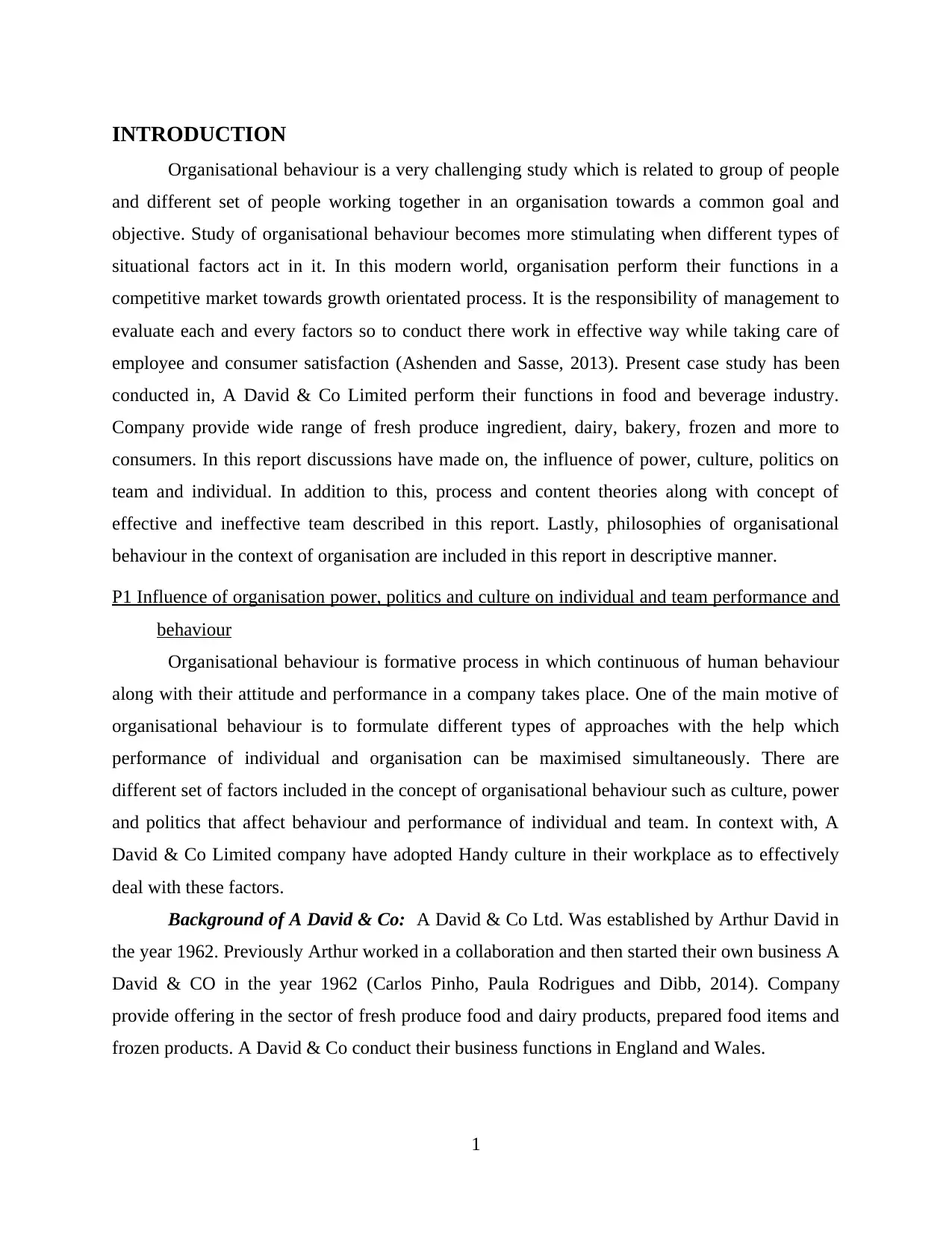
INTRODUCTION
Organisational behaviour is a very challenging study which is related to group of people
and different set of people working together in an organisation towards a common goal and
objective. Study of organisational behaviour becomes more stimulating when different types of
situational factors act in it. In this modern world, organisation perform their functions in a
competitive market towards growth orientated process. It is the responsibility of management to
evaluate each and every factors so to conduct there work in effective way while taking care of
employee and consumer satisfaction (Ashenden and Sasse, 2013). Present case study has been
conducted in, A David & Co Limited perform their functions in food and beverage industry.
Company provide wide range of fresh produce ingredient, dairy, bakery, frozen and more to
consumers. In this report discussions have made on, the influence of power, culture, politics on
team and individual. In addition to this, process and content theories along with concept of
effective and ineffective team described in this report. Lastly, philosophies of organisational
behaviour in the context of organisation are included in this report in descriptive manner.
P1 Influence of organisation power, politics and culture on individual and team performance and
behaviour
Organisational behaviour is formative process in which continuous of human behaviour
along with their attitude and performance in a company takes place. One of the main motive of
organisational behaviour is to formulate different types of approaches with the help which
performance of individual and organisation can be maximised simultaneously. There are
different set of factors included in the concept of organisational behaviour such as culture, power
and politics that affect behaviour and performance of individual and team. In context with, A
David & Co Limited company have adopted Handy culture in their workplace as to effectively
deal with these factors.
Background of A David & Co: A David & Co Ltd. Was established by Arthur David in
the year 1962. Previously Arthur worked in a collaboration and then started their own business A
David & CO in the year 1962 (Carlos Pinho, Paula Rodrigues and Dibb, 2014). Company
provide offering in the sector of fresh produce food and dairy products, prepared food items and
frozen products. A David & Co conduct their business functions in England and Wales.
1
Organisational behaviour is a very challenging study which is related to group of people
and different set of people working together in an organisation towards a common goal and
objective. Study of organisational behaviour becomes more stimulating when different types of
situational factors act in it. In this modern world, organisation perform their functions in a
competitive market towards growth orientated process. It is the responsibility of management to
evaluate each and every factors so to conduct there work in effective way while taking care of
employee and consumer satisfaction (Ashenden and Sasse, 2013). Present case study has been
conducted in, A David & Co Limited perform their functions in food and beverage industry.
Company provide wide range of fresh produce ingredient, dairy, bakery, frozen and more to
consumers. In this report discussions have made on, the influence of power, culture, politics on
team and individual. In addition to this, process and content theories along with concept of
effective and ineffective team described in this report. Lastly, philosophies of organisational
behaviour in the context of organisation are included in this report in descriptive manner.
P1 Influence of organisation power, politics and culture on individual and team performance and
behaviour
Organisational behaviour is formative process in which continuous of human behaviour
along with their attitude and performance in a company takes place. One of the main motive of
organisational behaviour is to formulate different types of approaches with the help which
performance of individual and organisation can be maximised simultaneously. There are
different set of factors included in the concept of organisational behaviour such as culture, power
and politics that affect behaviour and performance of individual and team. In context with, A
David & Co Limited company have adopted Handy culture in their workplace as to effectively
deal with these factors.
Background of A David & Co: A David & Co Ltd. Was established by Arthur David in
the year 1962. Previously Arthur worked in a collaboration and then started their own business A
David & CO in the year 1962 (Carlos Pinho, Paula Rodrigues and Dibb, 2014). Company
provide offering in the sector of fresh produce food and dairy products, prepared food items and
frozen products. A David & Co conduct their business functions in England and Wales.
1
Paraphrase This Document
Need a fresh take? Get an instant paraphrase of this document with our AI Paraphraser
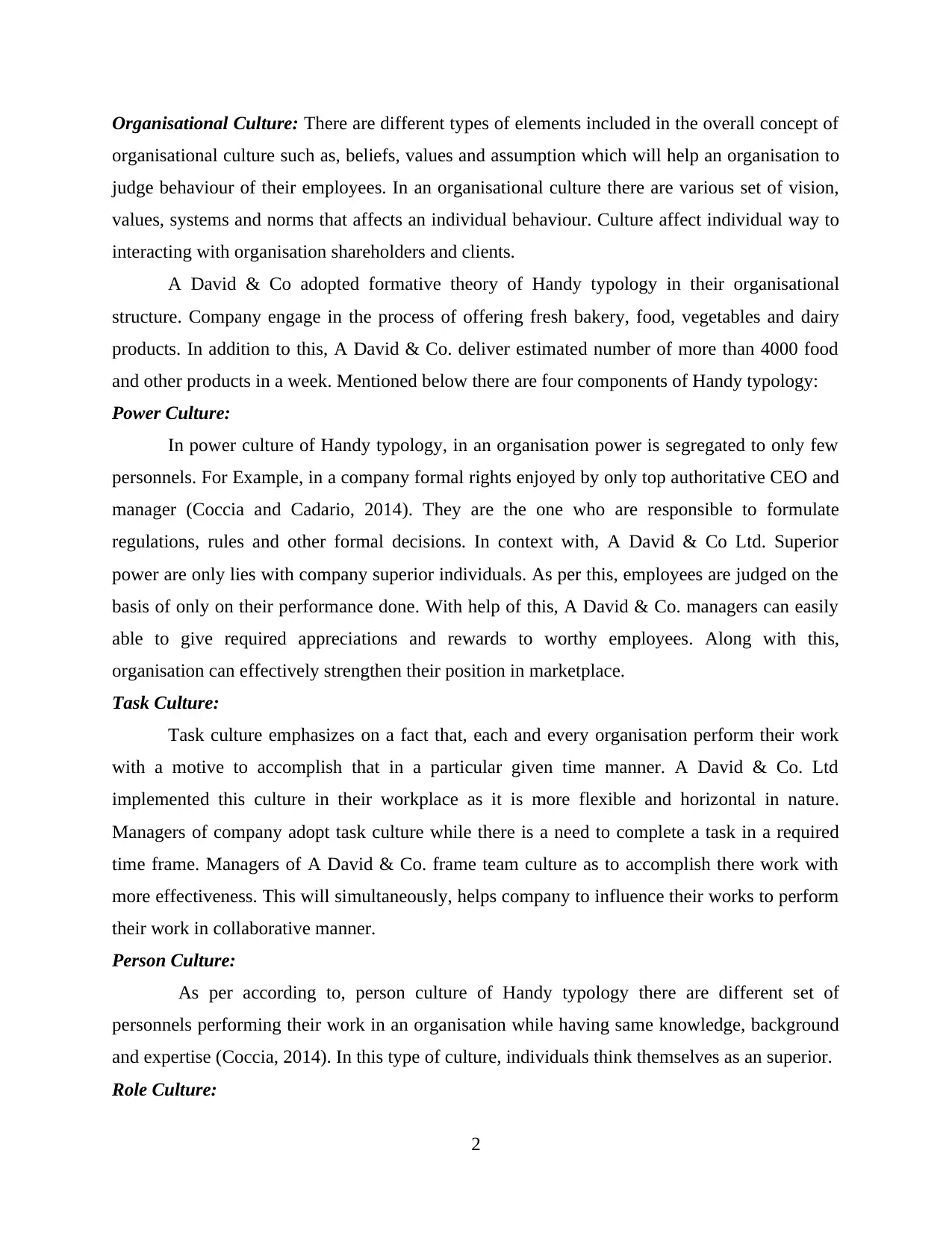
Organisational Culture: There are different types of elements included in the overall concept of
organisational culture such as, beliefs, values and assumption which will help an organisation to
judge behaviour of their employees. In an organisational culture there are various set of vision,
values, systems and norms that affects an individual behaviour. Culture affect individual way to
interacting with organisation shareholders and clients.
A David & Co adopted formative theory of Handy typology in their organisational
structure. Company engage in the process of offering fresh bakery, food, vegetables and dairy
products. In addition to this, A David & Co. deliver estimated number of more than 4000 food
and other products in a week. Mentioned below there are four components of Handy typology:
Power Culture:
In power culture of Handy typology, in an organisation power is segregated to only few
personnels. For Example, in a company formal rights enjoyed by only top authoritative CEO and
manager (Coccia and Cadario, 2014). They are the one who are responsible to formulate
regulations, rules and other formal decisions. In context with, A David & Co Ltd. Superior
power are only lies with company superior individuals. As per this, employees are judged on the
basis of only on their performance done. With help of this, A David & Co. managers can easily
able to give required appreciations and rewards to worthy employees. Along with this,
organisation can effectively strengthen their position in marketplace.
Task Culture:
Task culture emphasizes on a fact that, each and every organisation perform their work
with a motive to accomplish that in a particular given time manner. A David & Co. Ltd
implemented this culture in their workplace as it is more flexible and horizontal in nature.
Managers of company adopt task culture while there is a need to complete a task in a required
time frame. Managers of A David & Co. frame team culture as to accomplish there work with
more effectiveness. This will simultaneously, helps company to influence their works to perform
their work in collaborative manner.
Person Culture:
As per according to, person culture of Handy typology there are different set of
personnels performing their work in an organisation while having same knowledge, background
and expertise (Coccia, 2014). In this type of culture, individuals think themselves as an superior.
Role Culture:
2
organisational culture such as, beliefs, values and assumption which will help an organisation to
judge behaviour of their employees. In an organisational culture there are various set of vision,
values, systems and norms that affects an individual behaviour. Culture affect individual way to
interacting with organisation shareholders and clients.
A David & Co adopted formative theory of Handy typology in their organisational
structure. Company engage in the process of offering fresh bakery, food, vegetables and dairy
products. In addition to this, A David & Co. deliver estimated number of more than 4000 food
and other products in a week. Mentioned below there are four components of Handy typology:
Power Culture:
In power culture of Handy typology, in an organisation power is segregated to only few
personnels. For Example, in a company formal rights enjoyed by only top authoritative CEO and
manager (Coccia and Cadario, 2014). They are the one who are responsible to formulate
regulations, rules and other formal decisions. In context with, A David & Co Ltd. Superior
power are only lies with company superior individuals. As per this, employees are judged on the
basis of only on their performance done. With help of this, A David & Co. managers can easily
able to give required appreciations and rewards to worthy employees. Along with this,
organisation can effectively strengthen their position in marketplace.
Task Culture:
Task culture emphasizes on a fact that, each and every organisation perform their work
with a motive to accomplish that in a particular given time manner. A David & Co. Ltd
implemented this culture in their workplace as it is more flexible and horizontal in nature.
Managers of company adopt task culture while there is a need to complete a task in a required
time frame. Managers of A David & Co. frame team culture as to accomplish there work with
more effectiveness. This will simultaneously, helps company to influence their works to perform
their work in collaborative manner.
Person Culture:
As per according to, person culture of Handy typology there are different set of
personnels performing their work in an organisation while having same knowledge, background
and expertise (Coccia, 2014). In this type of culture, individuals think themselves as an superior.
Role Culture:
2
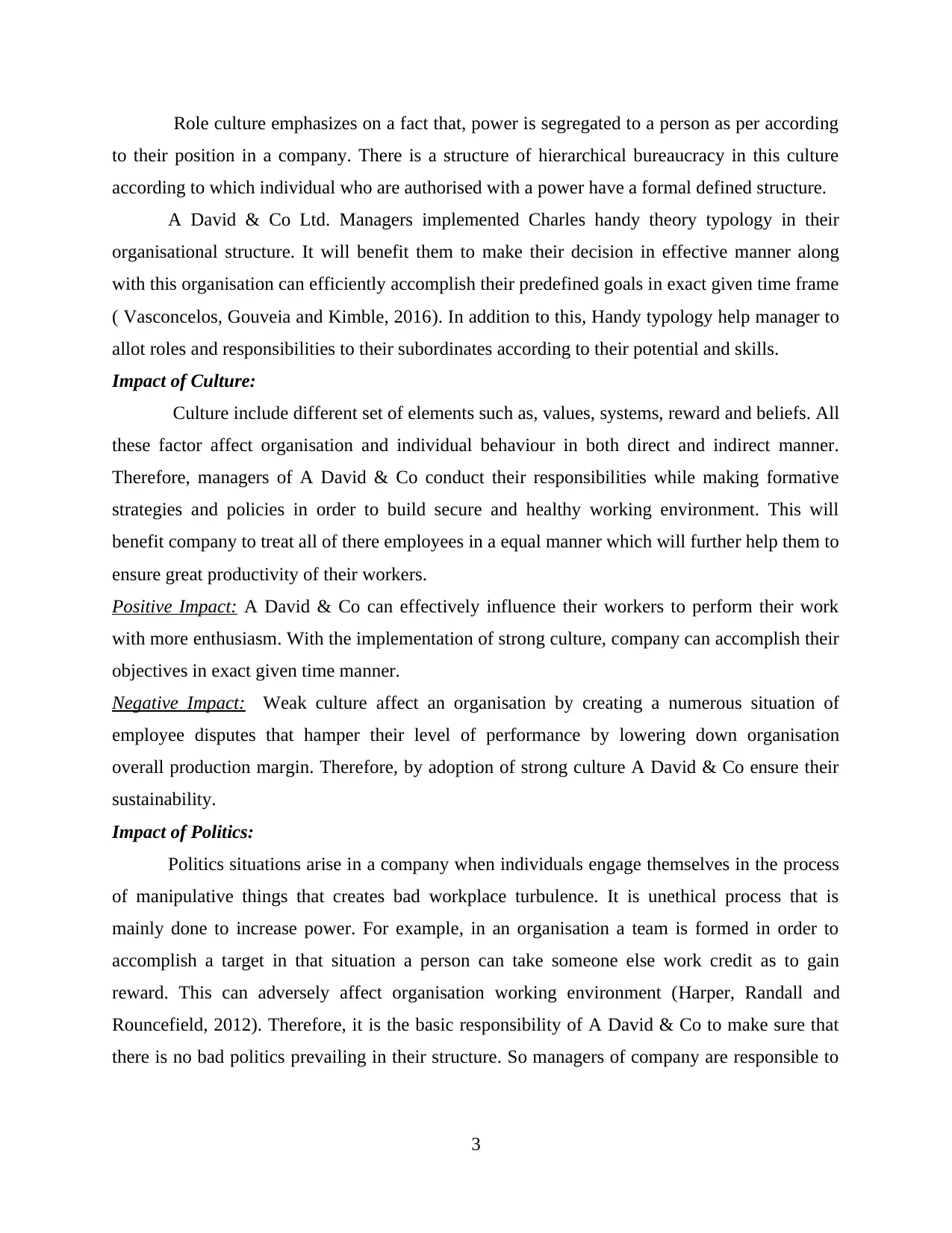
Role culture emphasizes on a fact that, power is segregated to a person as per according
to their position in a company. There is a structure of hierarchical bureaucracy in this culture
according to which individual who are authorised with a power have a formal defined structure.
A David & Co Ltd. Managers implemented Charles handy theory typology in their
organisational structure. It will benefit them to make their decision in effective manner along
with this organisation can efficiently accomplish their predefined goals in exact given time frame
( Vasconcelos, Gouveia and Kimble, 2016). In addition to this, Handy typology help manager to
allot roles and responsibilities to their subordinates according to their potential and skills.
Impact of Culture:
Culture include different set of elements such as, values, systems, reward and beliefs. All
these factor affect organisation and individual behaviour in both direct and indirect manner.
Therefore, managers of A David & Co conduct their responsibilities while making formative
strategies and policies in order to build secure and healthy working environment. This will
benefit company to treat all of there employees in a equal manner which will further help them to
ensure great productivity of their workers.
Positive Impact: A David & Co can effectively influence their workers to perform their work
with more enthusiasm. With the implementation of strong culture, company can accomplish their
objectives in exact given time manner.
Negative Impact: Weak culture affect an organisation by creating a numerous situation of
employee disputes that hamper their level of performance by lowering down organisation
overall production margin. Therefore, by adoption of strong culture A David & Co ensure their
sustainability.
Impact of Politics:
Politics situations arise in a company when individuals engage themselves in the process
of manipulative things that creates bad workplace turbulence. It is unethical process that is
mainly done to increase power. For example, in an organisation a team is formed in order to
accomplish a target in that situation a person can take someone else work credit as to gain
reward. This can adversely affect organisation working environment (Harper, Randall and
Rouncefield, 2012). Therefore, it is the basic responsibility of A David & Co to make sure that
there is no bad politics prevailing in their structure. So managers of company are responsible to
3
to their position in a company. There is a structure of hierarchical bureaucracy in this culture
according to which individual who are authorised with a power have a formal defined structure.
A David & Co Ltd. Managers implemented Charles handy theory typology in their
organisational structure. It will benefit them to make their decision in effective manner along
with this organisation can efficiently accomplish their predefined goals in exact given time frame
( Vasconcelos, Gouveia and Kimble, 2016). In addition to this, Handy typology help manager to
allot roles and responsibilities to their subordinates according to their potential and skills.
Impact of Culture:
Culture include different set of elements such as, values, systems, reward and beliefs. All
these factor affect organisation and individual behaviour in both direct and indirect manner.
Therefore, managers of A David & Co conduct their responsibilities while making formative
strategies and policies in order to build secure and healthy working environment. This will
benefit company to treat all of there employees in a equal manner which will further help them to
ensure great productivity of their workers.
Positive Impact: A David & Co can effectively influence their workers to perform their work
with more enthusiasm. With the implementation of strong culture, company can accomplish their
objectives in exact given time manner.
Negative Impact: Weak culture affect an organisation by creating a numerous situation of
employee disputes that hamper their level of performance by lowering down organisation
overall production margin. Therefore, by adoption of strong culture A David & Co ensure their
sustainability.
Impact of Politics:
Politics situations arise in a company when individuals engage themselves in the process
of manipulative things that creates bad workplace turbulence. It is unethical process that is
mainly done to increase power. For example, in an organisation a team is formed in order to
accomplish a target in that situation a person can take someone else work credit as to gain
reward. This can adversely affect organisation working environment (Harper, Randall and
Rouncefield, 2012). Therefore, it is the basic responsibility of A David & Co to make sure that
there is no bad politics prevailing in their structure. So managers of company are responsible to
3
⊘ This is a preview!⊘
Do you want full access?
Subscribe today to unlock all pages.

Trusted by 1+ million students worldwide
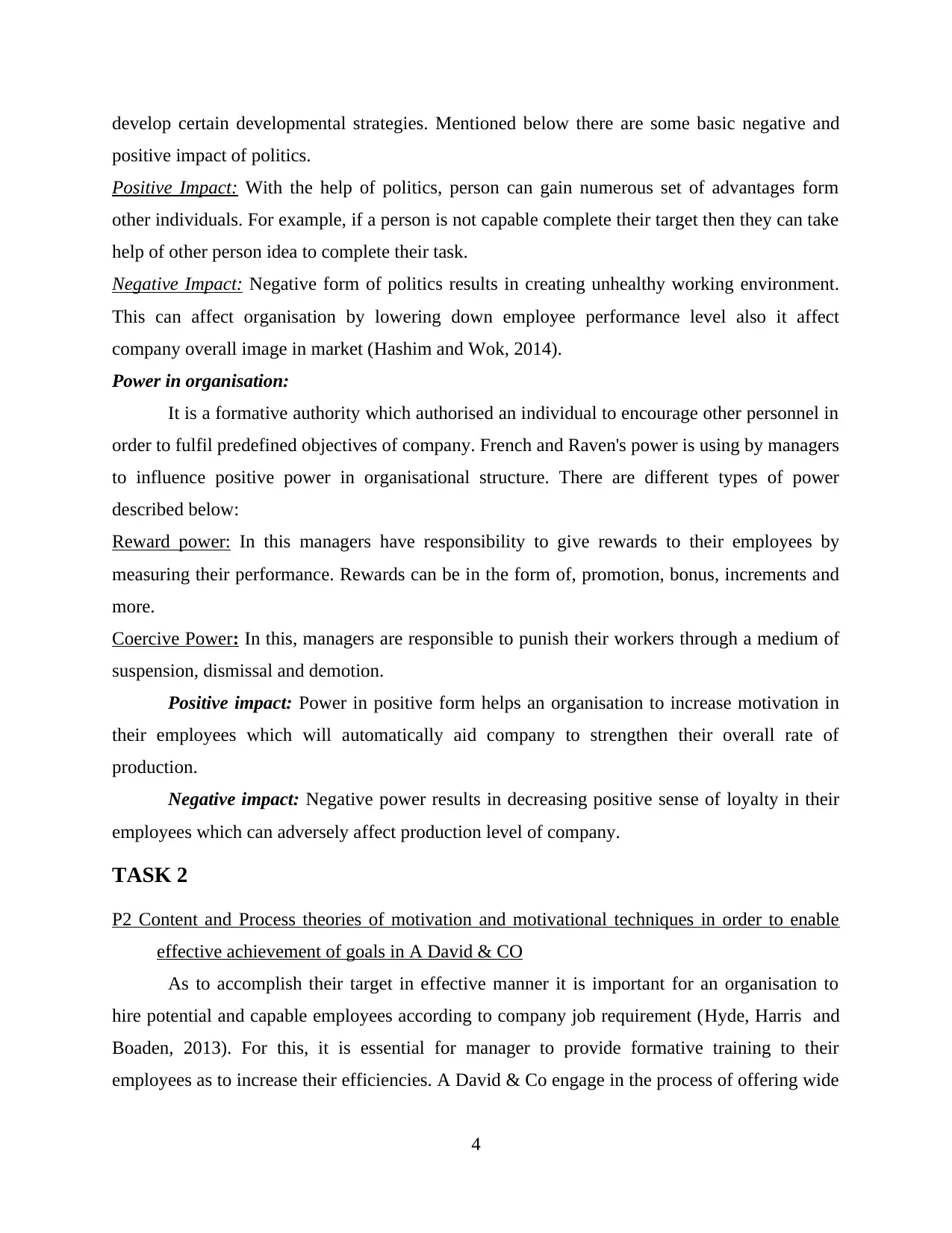
develop certain developmental strategies. Mentioned below there are some basic negative and
positive impact of politics.
Positive Impact: With the help of politics, person can gain numerous set of advantages form
other individuals. For example, if a person is not capable complete their target then they can take
help of other person idea to complete their task.
Negative Impact: Negative form of politics results in creating unhealthy working environment.
This can affect organisation by lowering down employee performance level also it affect
company overall image in market (Hashim and Wok, 2014).
Power in organisation:
It is a formative authority which authorised an individual to encourage other personnel in
order to fulfil predefined objectives of company. French and Raven's power is using by managers
to influence positive power in organisational structure. There are different types of power
described below:
Reward power: In this managers have responsibility to give rewards to their employees by
measuring their performance. Rewards can be in the form of, promotion, bonus, increments and
more.
Coercive Power: In this, managers are responsible to punish their workers through a medium of
suspension, dismissal and demotion.
Positive impact: Power in positive form helps an organisation to increase motivation in
their employees which will automatically aid company to strengthen their overall rate of
production.
Negative impact: Negative power results in decreasing positive sense of loyalty in their
employees which can adversely affect production level of company.
TASK 2
P2 Content and Process theories of motivation and motivational techniques in order to enable
effective achievement of goals in A David & CO
As to accomplish their target in effective manner it is important for an organisation to
hire potential and capable employees according to company job requirement (Hyde, Harris and
Boaden, 2013). For this, it is essential for manager to provide formative training to their
employees as to increase their efficiencies. A David & Co engage in the process of offering wide
4
positive impact of politics.
Positive Impact: With the help of politics, person can gain numerous set of advantages form
other individuals. For example, if a person is not capable complete their target then they can take
help of other person idea to complete their task.
Negative Impact: Negative form of politics results in creating unhealthy working environment.
This can affect organisation by lowering down employee performance level also it affect
company overall image in market (Hashim and Wok, 2014).
Power in organisation:
It is a formative authority which authorised an individual to encourage other personnel in
order to fulfil predefined objectives of company. French and Raven's power is using by managers
to influence positive power in organisational structure. There are different types of power
described below:
Reward power: In this managers have responsibility to give rewards to their employees by
measuring their performance. Rewards can be in the form of, promotion, bonus, increments and
more.
Coercive Power: In this, managers are responsible to punish their workers through a medium of
suspension, dismissal and demotion.
Positive impact: Power in positive form helps an organisation to increase motivation in
their employees which will automatically aid company to strengthen their overall rate of
production.
Negative impact: Negative power results in decreasing positive sense of loyalty in their
employees which can adversely affect production level of company.
TASK 2
P2 Content and Process theories of motivation and motivational techniques in order to enable
effective achievement of goals in A David & CO
As to accomplish their target in effective manner it is important for an organisation to
hire potential and capable employees according to company job requirement (Hyde, Harris and
Boaden, 2013). For this, it is essential for manager to provide formative training to their
employees as to increase their efficiencies. A David & Co engage in the process of offering wide
4
Paraphrase This Document
Need a fresh take? Get an instant paraphrase of this document with our AI Paraphraser
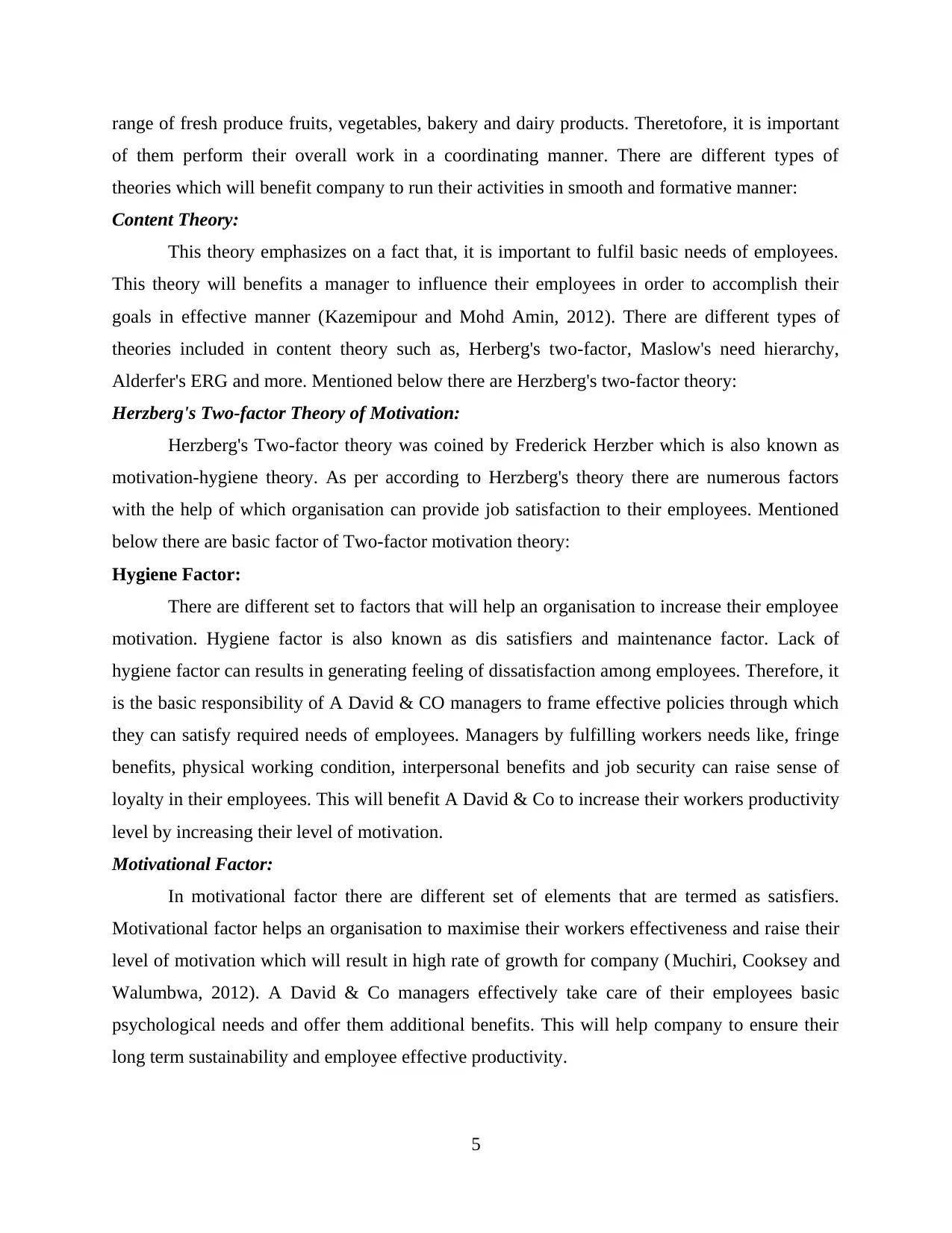
range of fresh produce fruits, vegetables, bakery and dairy products. Theretofore, it is important
of them perform their overall work in a coordinating manner. There are different types of
theories which will benefit company to run their activities in smooth and formative manner:
Content Theory:
This theory emphasizes on a fact that, it is important to fulfil basic needs of employees.
This theory will benefits a manager to influence their employees in order to accomplish their
goals in effective manner (Kazemipour and Mohd Amin, 2012). There are different types of
theories included in content theory such as, Herberg's two-factor, Maslow's need hierarchy,
Alderfer's ERG and more. Mentioned below there are Herzberg's two-factor theory:
Herzberg's Two-factor Theory of Motivation:
Herzberg's Two-factor theory was coined by Frederick Herzber which is also known as
motivation-hygiene theory. As per according to Herzberg's theory there are numerous factors
with the help of which organisation can provide job satisfaction to their employees. Mentioned
below there are basic factor of Two-factor motivation theory:
Hygiene Factor:
There are different set to factors that will help an organisation to increase their employee
motivation. Hygiene factor is also known as dis satisfiers and maintenance factor. Lack of
hygiene factor can results in generating feeling of dissatisfaction among employees. Therefore, it
is the basic responsibility of A David & CO managers to frame effective policies through which
they can satisfy required needs of employees. Managers by fulfilling workers needs like, fringe
benefits, physical working condition, interpersonal benefits and job security can raise sense of
loyalty in their employees. This will benefit A David & Co to increase their workers productivity
level by increasing their level of motivation.
Motivational Factor:
In motivational factor there are different set of elements that are termed as satisfiers.
Motivational factor helps an organisation to maximise their workers effectiveness and raise their
level of motivation which will result in high rate of growth for company (Muchiri, Cooksey and
Walumbwa, 2012). A David & Co managers effectively take care of their employees basic
psychological needs and offer them additional benefits. This will help company to ensure their
long term sustainability and employee effective productivity.
5
of them perform their overall work in a coordinating manner. There are different types of
theories which will benefit company to run their activities in smooth and formative manner:
Content Theory:
This theory emphasizes on a fact that, it is important to fulfil basic needs of employees.
This theory will benefits a manager to influence their employees in order to accomplish their
goals in effective manner (Kazemipour and Mohd Amin, 2012). There are different types of
theories included in content theory such as, Herberg's two-factor, Maslow's need hierarchy,
Alderfer's ERG and more. Mentioned below there are Herzberg's two-factor theory:
Herzberg's Two-factor Theory of Motivation:
Herzberg's Two-factor theory was coined by Frederick Herzber which is also known as
motivation-hygiene theory. As per according to Herzberg's theory there are numerous factors
with the help of which organisation can provide job satisfaction to their employees. Mentioned
below there are basic factor of Two-factor motivation theory:
Hygiene Factor:
There are different set to factors that will help an organisation to increase their employee
motivation. Hygiene factor is also known as dis satisfiers and maintenance factor. Lack of
hygiene factor can results in generating feeling of dissatisfaction among employees. Therefore, it
is the basic responsibility of A David & CO managers to frame effective policies through which
they can satisfy required needs of employees. Managers by fulfilling workers needs like, fringe
benefits, physical working condition, interpersonal benefits and job security can raise sense of
loyalty in their employees. This will benefit A David & Co to increase their workers productivity
level by increasing their level of motivation.
Motivational Factor:
In motivational factor there are different set of elements that are termed as satisfiers.
Motivational factor helps an organisation to maximise their workers effectiveness and raise their
level of motivation which will result in high rate of growth for company (Muchiri, Cooksey and
Walumbwa, 2012). A David & Co managers effectively take care of their employees basic
psychological needs and offer them additional benefits. This will help company to ensure their
long term sustainability and employee effective productivity.
5
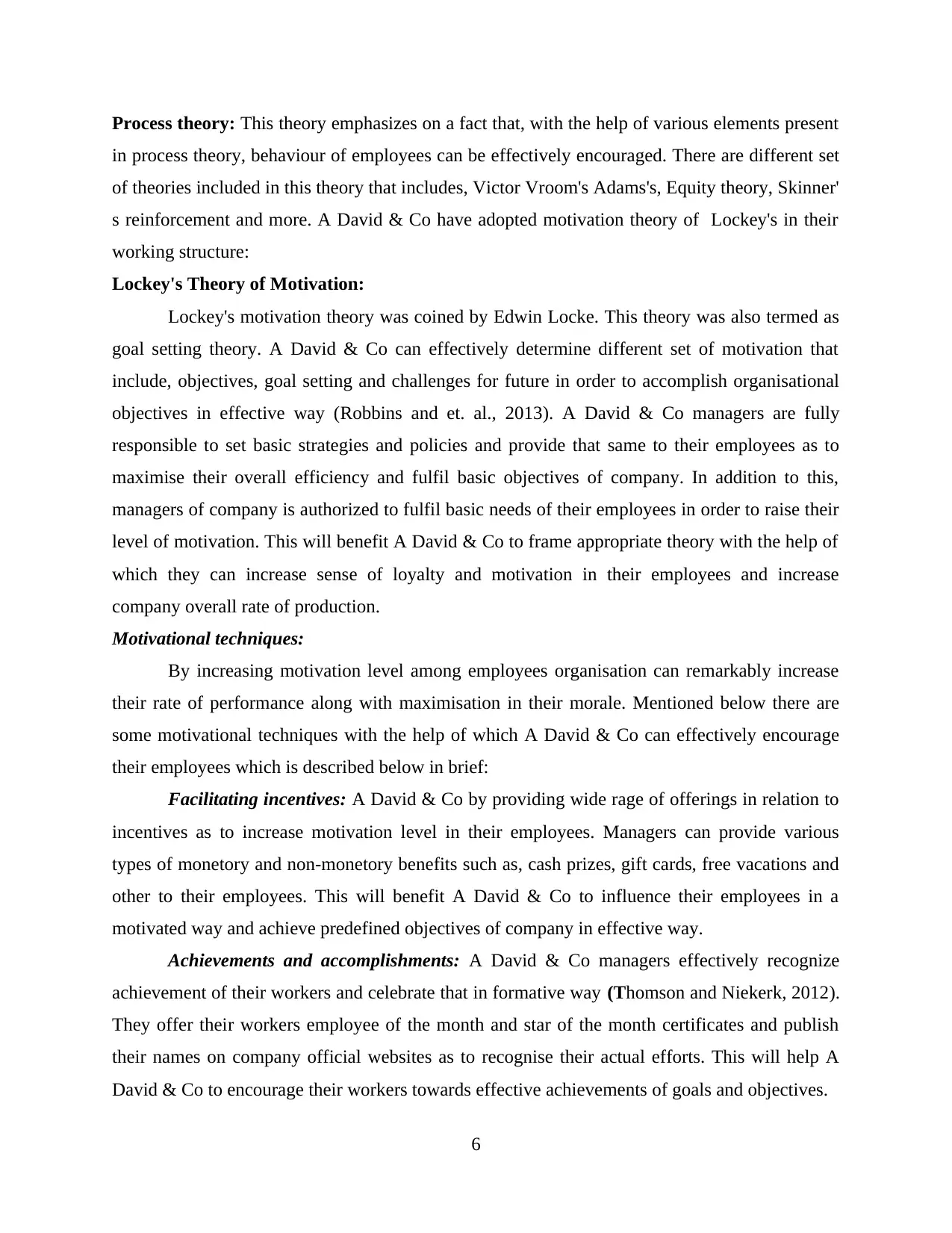
Process theory: This theory emphasizes on a fact that, with the help of various elements present
in process theory, behaviour of employees can be effectively encouraged. There are different set
of theories included in this theory that includes, Victor Vroom's Adams's, Equity theory, Skinner'
s reinforcement and more. A David & Co have adopted motivation theory of Lockey's in their
working structure:
Lockey's Theory of Motivation:
Lockey's motivation theory was coined by Edwin Locke. This theory was also termed as
goal setting theory. A David & Co can effectively determine different set of motivation that
include, objectives, goal setting and challenges for future in order to accomplish organisational
objectives in effective way (Robbins and et. al., 2013). A David & Co managers are fully
responsible to set basic strategies and policies and provide that same to their employees as to
maximise their overall efficiency and fulfil basic objectives of company. In addition to this,
managers of company is authorized to fulfil basic needs of their employees in order to raise their
level of motivation. This will benefit A David & Co to frame appropriate theory with the help of
which they can increase sense of loyalty and motivation in their employees and increase
company overall rate of production.
Motivational techniques:
By increasing motivation level among employees organisation can remarkably increase
their rate of performance along with maximisation in their morale. Mentioned below there are
some motivational techniques with the help of which A David & Co can effectively encourage
their employees which is described below in brief:
Facilitating incentives: A David & Co by providing wide rage of offerings in relation to
incentives as to increase motivation level in their employees. Managers can provide various
types of monetory and non-monetory benefits such as, cash prizes, gift cards, free vacations and
other to their employees. This will benefit A David & Co to influence their employees in a
motivated way and achieve predefined objectives of company in effective way.
Achievements and accomplishments: A David & Co managers effectively recognize
achievement of their workers and celebrate that in formative way (Thomson and Niekerk, 2012).
They offer their workers employee of the month and star of the month certificates and publish
their names on company official websites as to recognise their actual efforts. This will help A
David & Co to encourage their workers towards effective achievements of goals and objectives.
6
in process theory, behaviour of employees can be effectively encouraged. There are different set
of theories included in this theory that includes, Victor Vroom's Adams's, Equity theory, Skinner'
s reinforcement and more. A David & Co have adopted motivation theory of Lockey's in their
working structure:
Lockey's Theory of Motivation:
Lockey's motivation theory was coined by Edwin Locke. This theory was also termed as
goal setting theory. A David & Co can effectively determine different set of motivation that
include, objectives, goal setting and challenges for future in order to accomplish organisational
objectives in effective way (Robbins and et. al., 2013). A David & Co managers are fully
responsible to set basic strategies and policies and provide that same to their employees as to
maximise their overall efficiency and fulfil basic objectives of company. In addition to this,
managers of company is authorized to fulfil basic needs of their employees in order to raise their
level of motivation. This will benefit A David & Co to frame appropriate theory with the help of
which they can increase sense of loyalty and motivation in their employees and increase
company overall rate of production.
Motivational techniques:
By increasing motivation level among employees organisation can remarkably increase
their rate of performance along with maximisation in their morale. Mentioned below there are
some motivational techniques with the help of which A David & Co can effectively encourage
their employees which is described below in brief:
Facilitating incentives: A David & Co by providing wide rage of offerings in relation to
incentives as to increase motivation level in their employees. Managers can provide various
types of monetory and non-monetory benefits such as, cash prizes, gift cards, free vacations and
other to their employees. This will benefit A David & Co to influence their employees in a
motivated way and achieve predefined objectives of company in effective way.
Achievements and accomplishments: A David & Co managers effectively recognize
achievement of their workers and celebrate that in formative way (Thomson and Niekerk, 2012).
They offer their workers employee of the month and star of the month certificates and publish
their names on company official websites as to recognise their actual efforts. This will help A
David & Co to encourage their workers towards effective achievements of goals and objectives.
6
⊘ This is a preview!⊘
Do you want full access?
Subscribe today to unlock all pages.

Trusted by 1+ million students worldwide
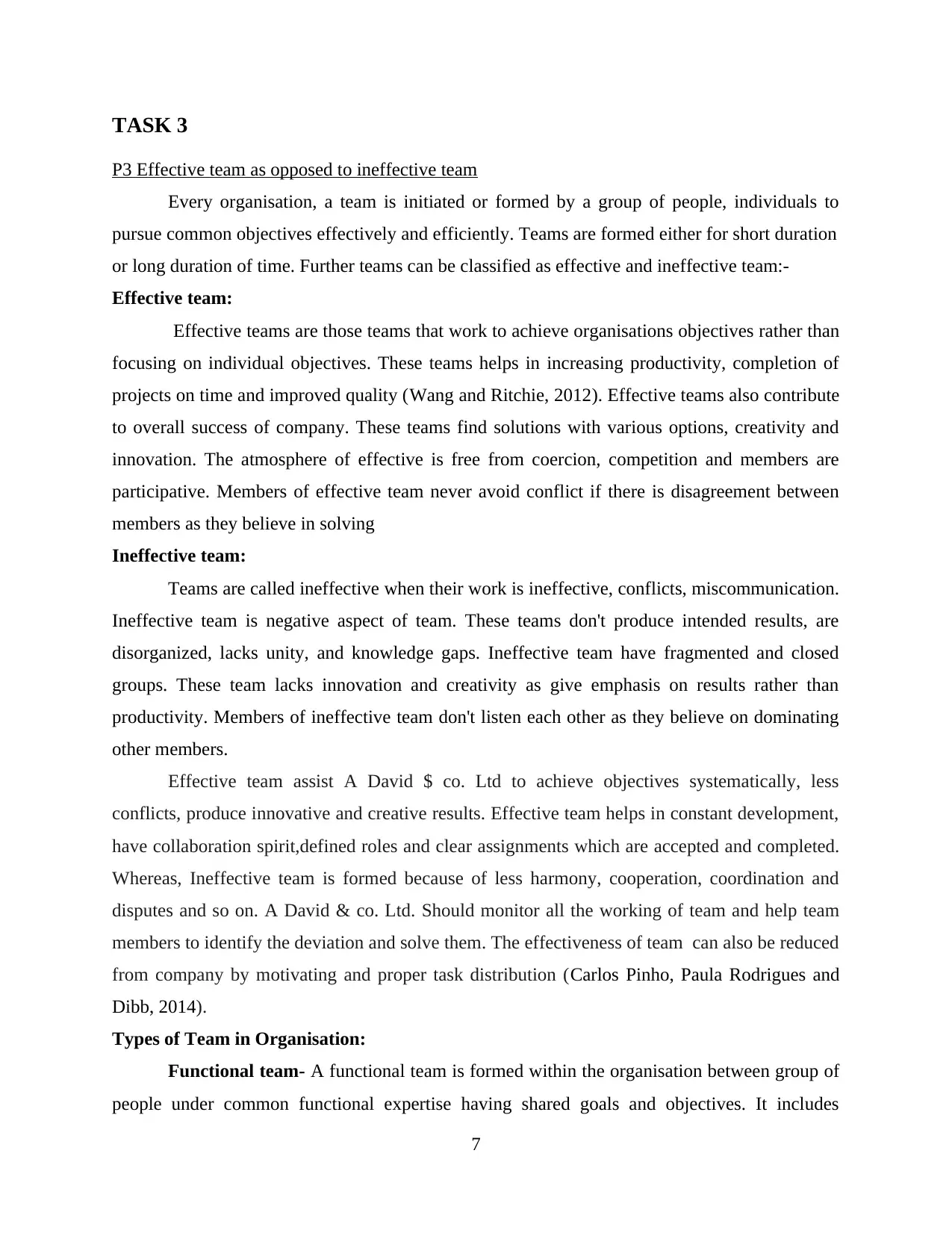
TASK 3
P3 Effective team as opposed to ineffective team
Every organisation, a team is initiated or formed by a group of people, individuals to
pursue common objectives effectively and efficiently. Teams are formed either for short duration
or long duration of time. Further teams can be classified as effective and ineffective team:-
Effective team:
Effective teams are those teams that work to achieve organisations objectives rather than
focusing on individual objectives. These teams helps in increasing productivity, completion of
projects on time and improved quality (Wang and Ritchie, 2012). Effective teams also contribute
to overall success of company. These teams find solutions with various options, creativity and
innovation. The atmosphere of effective is free from coercion, competition and members are
participative. Members of effective team never avoid conflict if there is disagreement between
members as they believe in solving
Ineffective team:
Teams are called ineffective when their work is ineffective, conflicts, miscommunication.
Ineffective team is negative aspect of team. These teams don't produce intended results, are
disorganized, lacks unity, and knowledge gaps. Ineffective team have fragmented and closed
groups. These team lacks innovation and creativity as give emphasis on results rather than
productivity. Members of ineffective team don't listen each other as they believe on dominating
other members.
Effective team assist A David $ co. Ltd to achieve objectives systematically, less
conflicts, produce innovative and creative results. Effective team helps in constant development,
have collaboration spirit,defined roles and clear assignments which are accepted and completed.
Whereas, Ineffective team is formed because of less harmony, cooperation, coordination and
disputes and so on. A David & co. Ltd. Should monitor all the working of team and help team
members to identify the deviation and solve them. The effectiveness of team can also be reduced
from company by motivating and proper task distribution (Carlos Pinho, Paula Rodrigues and
Dibb, 2014).
Types of Team in Organisation:
Functional team- A functional team is formed within the organisation between group of
people under common functional expertise having shared goals and objectives. It includes
7
P3 Effective team as opposed to ineffective team
Every organisation, a team is initiated or formed by a group of people, individuals to
pursue common objectives effectively and efficiently. Teams are formed either for short duration
or long duration of time. Further teams can be classified as effective and ineffective team:-
Effective team:
Effective teams are those teams that work to achieve organisations objectives rather than
focusing on individual objectives. These teams helps in increasing productivity, completion of
projects on time and improved quality (Wang and Ritchie, 2012). Effective teams also contribute
to overall success of company. These teams find solutions with various options, creativity and
innovation. The atmosphere of effective is free from coercion, competition and members are
participative. Members of effective team never avoid conflict if there is disagreement between
members as they believe in solving
Ineffective team:
Teams are called ineffective when their work is ineffective, conflicts, miscommunication.
Ineffective team is negative aspect of team. These teams don't produce intended results, are
disorganized, lacks unity, and knowledge gaps. Ineffective team have fragmented and closed
groups. These team lacks innovation and creativity as give emphasis on results rather than
productivity. Members of ineffective team don't listen each other as they believe on dominating
other members.
Effective team assist A David $ co. Ltd to achieve objectives systematically, less
conflicts, produce innovative and creative results. Effective team helps in constant development,
have collaboration spirit,defined roles and clear assignments which are accepted and completed.
Whereas, Ineffective team is formed because of less harmony, cooperation, coordination and
disputes and so on. A David & co. Ltd. Should monitor all the working of team and help team
members to identify the deviation and solve them. The effectiveness of team can also be reduced
from company by motivating and proper task distribution (Carlos Pinho, Paula Rodrigues and
Dibb, 2014).
Types of Team in Organisation:
Functional team- A functional team is formed within the organisation between group of
people under common functional expertise having shared goals and objectives. It includes
7
Paraphrase This Document
Need a fresh take? Get an instant paraphrase of this document with our AI Paraphraser
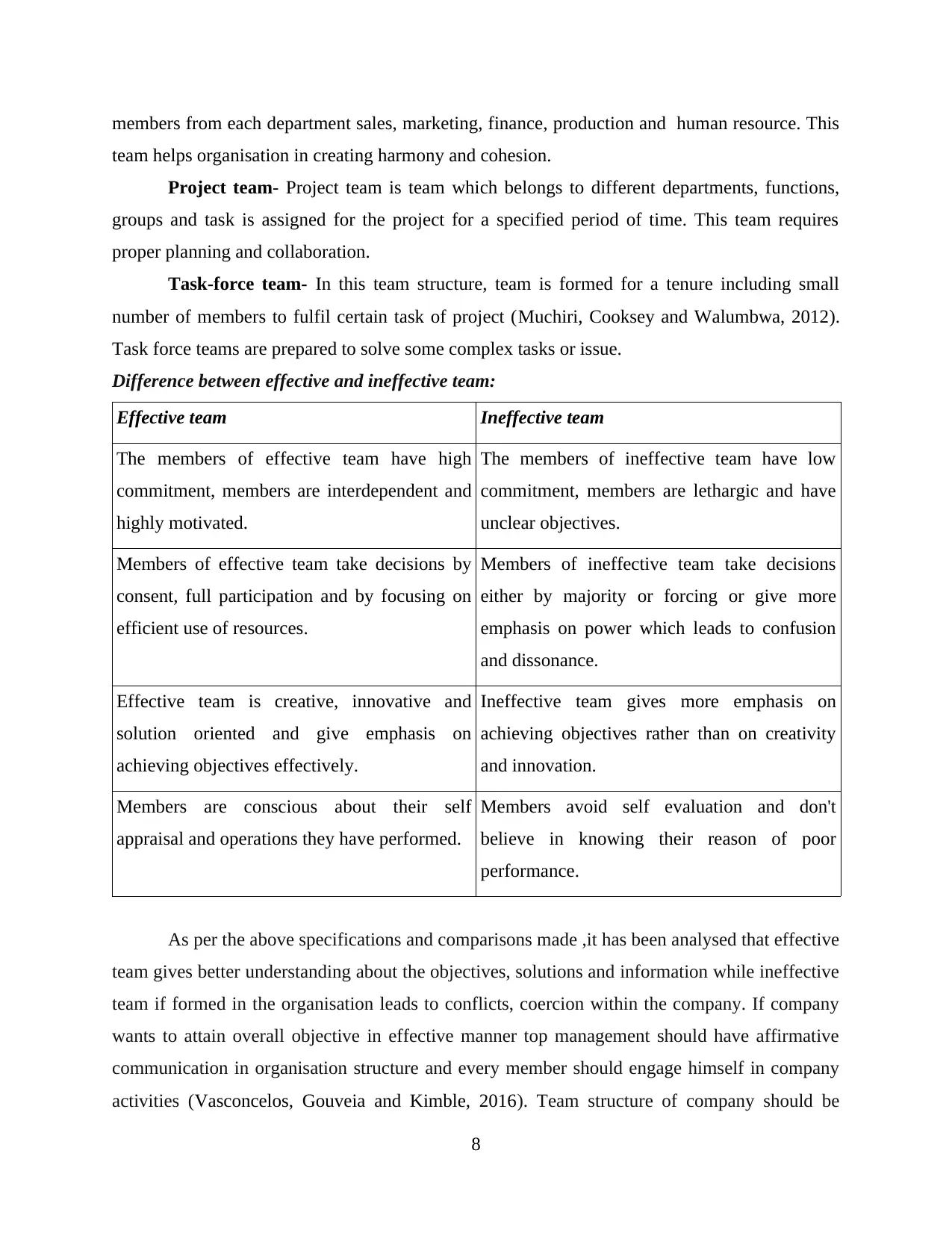
members from each department sales, marketing, finance, production and human resource. This
team helps organisation in creating harmony and cohesion.
Project team- Project team is team which belongs to different departments, functions,
groups and task is assigned for the project for a specified period of time. This team requires
proper planning and collaboration.
Task-force team- In this team structure, team is formed for a tenure including small
number of members to fulfil certain task of project (Muchiri, Cooksey and Walumbwa, 2012).
Task force teams are prepared to solve some complex tasks or issue.
Difference between effective and ineffective team:
Effective team Ineffective team
The members of effective team have high
commitment, members are interdependent and
highly motivated.
The members of ineffective team have low
commitment, members are lethargic and have
unclear objectives.
Members of effective team take decisions by
consent, full participation and by focusing on
efficient use of resources.
Members of ineffective team take decisions
either by majority or forcing or give more
emphasis on power which leads to confusion
and dissonance.
Effective team is creative, innovative and
solution oriented and give emphasis on
achieving objectives effectively.
Ineffective team gives more emphasis on
achieving objectives rather than on creativity
and innovation.
Members are conscious about their self
appraisal and operations they have performed.
Members avoid self evaluation and don't
believe in knowing their reason of poor
performance.
As per the above specifications and comparisons made ,it has been analysed that effective
team gives better understanding about the objectives, solutions and information while ineffective
team if formed in the organisation leads to conflicts, coercion within the company. If company
wants to attain overall objective in effective manner top management should have affirmative
communication in organisation structure and every member should engage himself in company
activities (Vasconcelos, Gouveia and Kimble, 2016). Team structure of company should be
8
team helps organisation in creating harmony and cohesion.
Project team- Project team is team which belongs to different departments, functions,
groups and task is assigned for the project for a specified period of time. This team requires
proper planning and collaboration.
Task-force team- In this team structure, team is formed for a tenure including small
number of members to fulfil certain task of project (Muchiri, Cooksey and Walumbwa, 2012).
Task force teams are prepared to solve some complex tasks or issue.
Difference between effective and ineffective team:
Effective team Ineffective team
The members of effective team have high
commitment, members are interdependent and
highly motivated.
The members of ineffective team have low
commitment, members are lethargic and have
unclear objectives.
Members of effective team take decisions by
consent, full participation and by focusing on
efficient use of resources.
Members of ineffective team take decisions
either by majority or forcing or give more
emphasis on power which leads to confusion
and dissonance.
Effective team is creative, innovative and
solution oriented and give emphasis on
achieving objectives effectively.
Ineffective team gives more emphasis on
achieving objectives rather than on creativity
and innovation.
Members are conscious about their self
appraisal and operations they have performed.
Members avoid self evaluation and don't
believe in knowing their reason of poor
performance.
As per the above specifications and comparisons made ,it has been analysed that effective
team gives better understanding about the objectives, solutions and information while ineffective
team if formed in the organisation leads to conflicts, coercion within the company. If company
wants to attain overall objective in effective manner top management should have affirmative
communication in organisation structure and every member should engage himself in company
activities (Vasconcelos, Gouveia and Kimble, 2016). Team structure of company should be
8
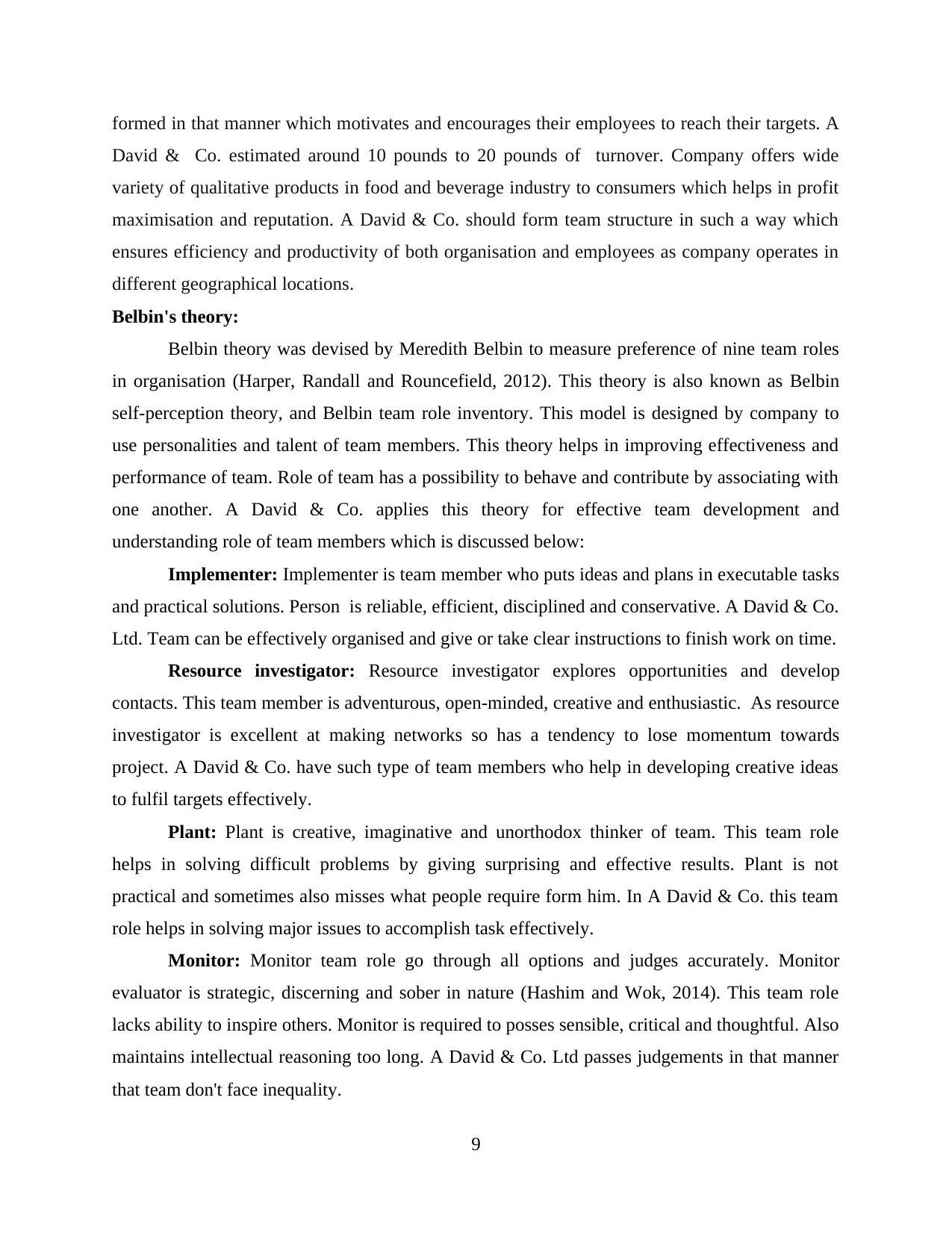
formed in that manner which motivates and encourages their employees to reach their targets. A
David & Co. estimated around 10 pounds to 20 pounds of turnover. Company offers wide
variety of qualitative products in food and beverage industry to consumers which helps in profit
maximisation and reputation. A David & Co. should form team structure in such a way which
ensures efficiency and productivity of both organisation and employees as company operates in
different geographical locations.
Belbin's theory:
Belbin theory was devised by Meredith Belbin to measure preference of nine team roles
in organisation (Harper, Randall and Rouncefield, 2012). This theory is also known as Belbin
self-perception theory, and Belbin team role inventory. This model is designed by company to
use personalities and talent of team members. This theory helps in improving effectiveness and
performance of team. Role of team has a possibility to behave and contribute by associating with
one another. A David & Co. applies this theory for effective team development and
understanding role of team members which is discussed below:
Implementer: Implementer is team member who puts ideas and plans in executable tasks
and practical solutions. Person is reliable, efficient, disciplined and conservative. A David & Co.
Ltd. Team can be effectively organised and give or take clear instructions to finish work on time.
Resource investigator: Resource investigator explores opportunities and develop
contacts. This team member is adventurous, open-minded, creative and enthusiastic. As resource
investigator is excellent at making networks so has a tendency to lose momentum towards
project. A David & Co. have such type of team members who help in developing creative ideas
to fulfil targets effectively.
Plant: Plant is creative, imaginative and unorthodox thinker of team. This team role
helps in solving difficult problems by giving surprising and effective results. Plant is not
practical and sometimes also misses what people require form him. In A David & Co. this team
role helps in solving major issues to accomplish task effectively.
Monitor: Monitor team role go through all options and judges accurately. Monitor
evaluator is strategic, discerning and sober in nature (Hashim and Wok, 2014). This team role
lacks ability to inspire others. Monitor is required to posses sensible, critical and thoughtful. Also
maintains intellectual reasoning too long. A David & Co. Ltd passes judgements in that manner
that team don't face inequality.
9
David & Co. estimated around 10 pounds to 20 pounds of turnover. Company offers wide
variety of qualitative products in food and beverage industry to consumers which helps in profit
maximisation and reputation. A David & Co. should form team structure in such a way which
ensures efficiency and productivity of both organisation and employees as company operates in
different geographical locations.
Belbin's theory:
Belbin theory was devised by Meredith Belbin to measure preference of nine team roles
in organisation (Harper, Randall and Rouncefield, 2012). This theory is also known as Belbin
self-perception theory, and Belbin team role inventory. This model is designed by company to
use personalities and talent of team members. This theory helps in improving effectiveness and
performance of team. Role of team has a possibility to behave and contribute by associating with
one another. A David & Co. applies this theory for effective team development and
understanding role of team members which is discussed below:
Implementer: Implementer is team member who puts ideas and plans in executable tasks
and practical solutions. Person is reliable, efficient, disciplined and conservative. A David & Co.
Ltd. Team can be effectively organised and give or take clear instructions to finish work on time.
Resource investigator: Resource investigator explores opportunities and develop
contacts. This team member is adventurous, open-minded, creative and enthusiastic. As resource
investigator is excellent at making networks so has a tendency to lose momentum towards
project. A David & Co. have such type of team members who help in developing creative ideas
to fulfil targets effectively.
Plant: Plant is creative, imaginative and unorthodox thinker of team. This team role
helps in solving difficult problems by giving surprising and effective results. Plant is not
practical and sometimes also misses what people require form him. In A David & Co. this team
role helps in solving major issues to accomplish task effectively.
Monitor: Monitor team role go through all options and judges accurately. Monitor
evaluator is strategic, discerning and sober in nature (Hashim and Wok, 2014). This team role
lacks ability to inspire others. Monitor is required to posses sensible, critical and thoughtful. Also
maintains intellectual reasoning too long. A David & Co. Ltd passes judgements in that manner
that team don't face inequality.
9
⊘ This is a preview!⊘
Do you want full access?
Subscribe today to unlock all pages.

Trusted by 1+ million students worldwide
1 out of 16
Related Documents
Your All-in-One AI-Powered Toolkit for Academic Success.
+13062052269
info@desklib.com
Available 24*7 on WhatsApp / Email
![[object Object]](/_next/static/media/star-bottom.7253800d.svg)
Unlock your academic potential
Copyright © 2020–2025 A2Z Services. All Rights Reserved. Developed and managed by ZUCOL.





